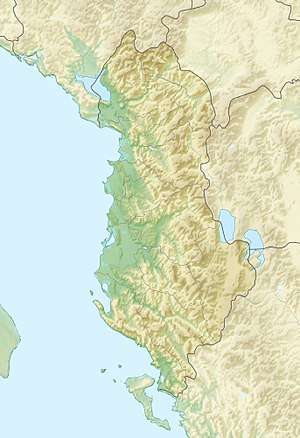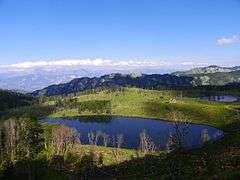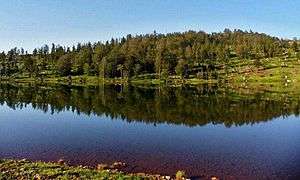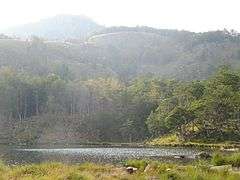Lurë National Park
| Lurë National Park | |
|---|---|
|
IUCN category II (national park) | |
|
| |
 | |
| Location | Dibër County |
| Nearest city | Peshkopi |
| Coordinates | 41°48′0″N 20°14′0″E / 41.80000°N 20.23333°ECoordinates: 41°48′0″N 20°14′0″E / 41.80000°N 20.23333°E |
| Area | 1,280 hectares (12.8 km2)[1] |
| Established | 21 November 1966[2][3] |
| Governing body | Ministry of Environment |
The Lurë National Park (Albanian: Parku Kombëtar i Lurës) is a national park in northeastern Albania, spanning an area of 12.8 km2 (4.9 sq mi), encompassing as well the eastern section of Kunora e Lurës. The park was established in 1966 to protect the various ecosystems and biodiversity. The altitude vary from 1,500–2,300 m (4,921–7,546 ft).[4] The International Union for Conservation of Nature (IUCN) has listed the park as Category II. Nevertheless, it is described as an important Bird and Plant Area, because it supports significant bird and plant species.[5][6]
In behalf to a great variability in elevation, Lurë National Park is densely populated in vegetation. Higher plant life consists mainly of both coniferous and deciduous trees, particularly around the shores of the lakes. The most common tree native to Lurë is the european beech along with silver fir, black pine, red pine and bosnian pine. Especially protected is the balkan pine, which is threatened with extinction and only common in the west of the Balkan Peninsula. The southern section of the park has a meadow of multicolour flowers and several coniferous trees, which is called the Field of Mares, offering pristine views over the landscape. In terms of phytogeography, the park falls within the Pindus Mountains mixed forests terrestrial ecoregion of the Palearctic Mediterranean forests, woodlands, and scrub.
The park shelters numerous species. Most important wildlife inhabiting the park includes the european brown bear, eurasian lynx, eurasian wolf, european pine marten, roe deer and western capercaillie.[7] Small mammals include the red squirrel and edible dormouse.[8] The twelve glacial lakes within the national park were formed during the ice age.[9] They are located in the northeastern part of the nation in the Dibër County at an elevation between 1,200 and 1,500 m (3,937 and 4,921 ft). Each lake carries a name associated with its most characteristic feature.
According to Albanian poet Gjergj Fishta, "Him/her who has not seen Lura, he/she has not seen Albania", meanwhile British renown traveler Edith Durham has been quoted as follows: "When I came up the Qafë Lurë, I saw such a beautiful field, that I had never seen in any place of the Balkans".
However, following the fall of communism in the 1990s, the area suffered massive deforestation from illegal logging and forest fires that severely affected ecosystems. In fact, it is estimated that as far as 50% of the park's area has been destroyed. In 2014, the Government of Albania launched a controversial rehabilitation campaign including reforestation, roadwork, and the putting of new signs.[10][11]
Local stakeholders have criticized the project as merely superficial. In the meantime, non-governmental organizations are trying to revitalize the park by contributing in the planting of trees and removal of debris around the lakes, some of which are drying up. Nature is also helping by naturally spreading seeds of new trees which are growing at different areas of the park. Accommodation consists of several family run hotels and guesthouses near the park in Fushe-Lure. The area around Lura features traditional tower houses, the once industrial mining town of Kurbnesh, Ottomam mosques, and a recently renovated Catholic Church. The region is also home to Albanian Independence signatory Dom Nikollë Kaçorri.
Outlook
In 2018, the Albanian government outlined a plan that would turn the area into an agritourism hotspot through the renovation of the traditional tower houses and the reconstruction of the road connecting the park with Rreshen and the A1 motorway. Plans also include the widening of the current coverage area of the national park to include surrounding attractions such as canyons and waterfalls.
Gallery
 Liqeni i Kallabës
Liqeni i Kallabës Liqeni i Lurës
Liqeni i Lurës.jpg) Liqeni i Madh from the top
Liqeni i Madh from the top Liqeni i Madh
Liqeni i Madh View of the lake
View of the lake
See also
| Wikivoyage has a travel guide for Lure National Park. |
References
- ↑ University of Tirana. "TURIZMI NË RRETHIN E DIBRËS" (PDF). doktoratura.unitir.edu.al (in Albanian). Tirana. p. 40.
- ↑ "RRJETI I ZONAVE TË MBROJTURA NË SHQIPËRI" (PDF). mjedisi.gov.al (in Albanian). p. 1.
- ↑ "PROTECTED AREAS IN THE DISTRICT OF DIBRA AND ASSESSMENT OF THEIR TOURIST" (PDF). idpublications.org. p. 13.
Lura national park, declared by DCM no. 96, dated 21.11.1966, with a total area of 1280 hectares (category II).
- ↑ "Lura Geopark Albania" (PDF). progeo.ngo. p. 2.
The most widespread trees in this forest is beech, which begins from 900-1000m above the sea level up to the most upper level of the forest (1900-2000m).
- ↑ BirdLife International. "Lura". datazone.birdlife.org (in Englisch).
- ↑ IUCN, World Wide Fund for Nature, Plantlife. "Important Plant Areas of the south and east Mediterranean region" (PDF). portals.iucn.org. p. 75.
- ↑ "Lura National Park". akzm.gov.al.
Large protected mammals as bear (Ursus arctos), wolf (Canis lupus), lynx (Felis lynx), chamois (Rupicapra rupicapra), roe deer (Capreolus capreolus), among birds we highlight the presence of the wild turkey ( Tatrao urogallus ) and eagles (Aquila chrysaetos).
- ↑ University of Tirana. "Small terrestrial mammals of Albania: distribution and diversity (Mammalia, Eulipotyphla, Rodentia)" (PDF). zookeys.pensoft.net. Tirana.
- ↑ "PROTECTED AREAS IN THE DISTRICT OF DIBRA AND ASSESSMENT OF THEIR TOURIST" (PDF). idpublications.org. p. 14.
The lakes are formed in the quaternary geologic period about 4-5 million years ago, when the highest mountains in Europe were covered with thick ice, and other regions too, up to hundreds of meters
- ↑ "2 million trees for the Lura Park". top-channel.tv. 10 June 2014.
More than 2 million trees will be planned in 300 hectares. The General Secretary at the Ministry of Environment, Alqi Bllako, declared that the Ministry has contacted two private companies which will pave 18 kilometers of road within two years, rehabilitate the area and clean the lakes.
- ↑ "Initiation of Lura National Park rehabilitation and reforestation project". ata.gov.al. 14 June 2014.
Rehabilitation of Lura National Park aims to create opportunities for sustainable tourism development in the area, provide employment opportunities for local residents, aiming to minimize the illegal pressures on natural resources of the area and returning the balance of rural tourism development, in view of the natural resources and products offered by the area.
